Geoffrey I. Webb
CEDL: Centre-Enhanced Discriminative Learning for Anomaly Detection
Nov 15, 2025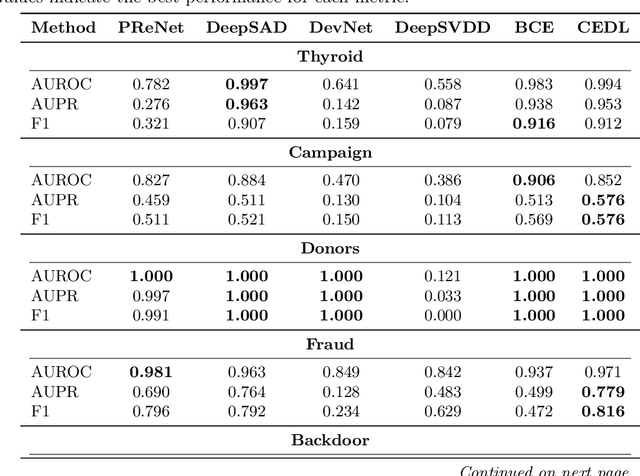
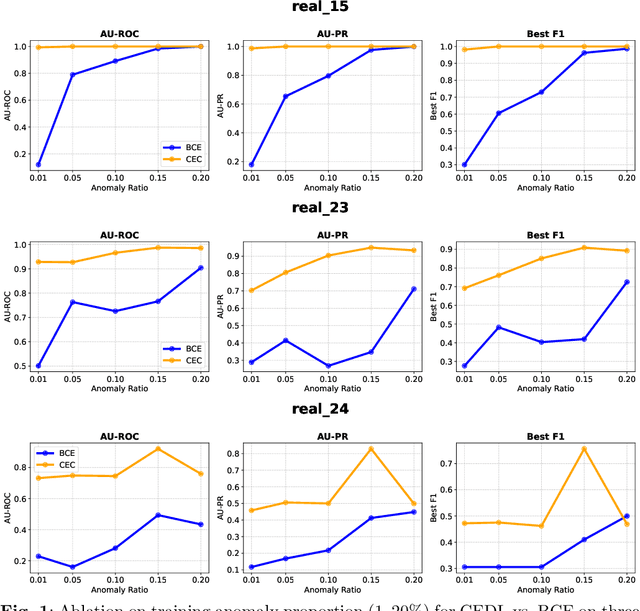
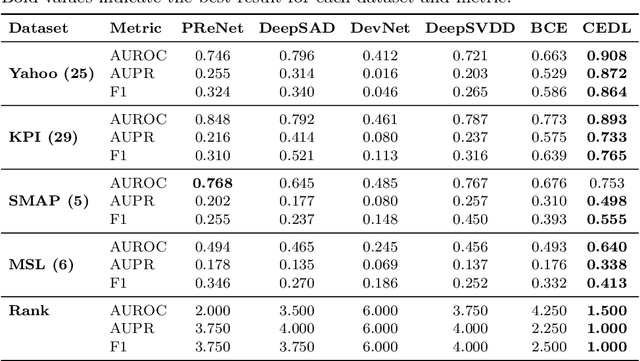
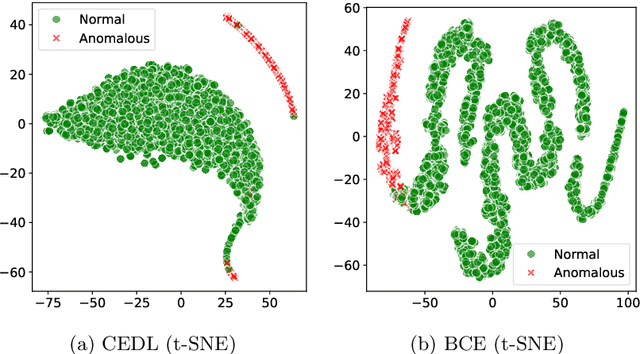
Abstract:Supervised anomaly detection methods perform well in identifying known anomalies that are well represented in the training set. However, they often struggle to generalise beyond the training distribution due to decision boundaries that lack a clear definition of normality. Existing approaches typically address this by regularising the representation space during training, leading to separate optimisation in latent and label spaces. The learned normality is therefore not directly utilised at inference, and their anomaly scores often fall within arbitrary ranges that require explicit mapping or calibration for probabilistic interpretation. To achieve unified learning of geometric normality and label discrimination, we propose Centre-Enhanced Discriminative Learning (CEDL), a novel supervised anomaly detection framework that embeds geometric normality directly into the discriminative objective. CEDL reparameterises the conventional sigmoid-derived prediction logit through a centre-based radial distance function, unifying geometric and discriminative learning in a single end-to-end formulation. This design enables interpretable, geometry-aware anomaly scoring without post-hoc thresholding or reference calibration. Extensive experiments on tabular, time-series, and image data demonstrate that CEDL achieves competitive and balanced performance across diverse real-world anomaly detection tasks, validating its effectiveness and broad applicability.
EEG-X: Device-Agnostic and Noise-Robust Foundation Model for EEG
Nov 12, 2025



Abstract:Foundation models for EEG analysis are still in their infancy, limited by two key challenges: (1) variability across datasets caused by differences in recording devices and configurations, and (2) the low signal-to-noise ratio (SNR) of EEG, where brain signals are often buried under artifacts and non-brain sources. To address these challenges, we present EEG-X, a device-agnostic and noise-robust foundation model for EEG representation learning. EEG-X introduces a novel location-based channel embedding that encodes spatial information and improves generalization across domains and tasks by allowing the model to handle varying channel numbers, combinations, and recording lengths. To enhance robustness against noise, EEG-X employs a noise-aware masking and reconstruction strategy in both raw and latent spaces. Unlike previous models that mask and reconstruct raw noisy EEG signals, EEG-X is trained to reconstruct denoised signals obtained through an artifact removal process, ensuring that the learned representations focus on neural activity rather than noise. To further enhance reconstruction-based pretraining, EEG-X introduces a dictionary-inspired convolutional transformation (DiCT) layer that projects signals into a structured feature space before computing reconstruction (MSE) loss, reducing noise sensitivity and capturing frequency- and shape-aware similarities. Experiments on datasets collected from diverse devices show that EEG-X outperforms state-of-the-art methods across multiple downstream EEG tasks and excels in cross-domain settings where pre-trained and downstream datasets differ in electrode layouts. The models and code are available at: https://github.com/Emotiv/EEG-X
Interpretable Representation Learning for Additive Rule Ensembles
Jun 26, 2025



Abstract:Small additive ensembles of symbolic rules offer interpretable prediction models. Traditionally, these ensembles use rule conditions based on conjunctions of simple threshold propositions $x \geq t$ on a single input variable $x$ and threshold $t$, resulting geometrically in axis-parallel polytopes as decision regions. While this form ensures a high degree of interpretability for individual rules and can be learned efficiently using the gradient boosting approach, it relies on having access to a curated set of expressive and ideally independent input features so that a small ensemble of axis-parallel regions can describe the target variable well. Absent such features, reaching sufficient accuracy requires increasing the number and complexity of individual rules, which diminishes the interpretability of the model. Here, we extend classical rule ensembles by introducing logical propositions with learnable sparse linear transformations of input variables, i.e., propositions of the form $\mathbf{x}^\mathrm{T}\mathbf{w} \geq t$, where $\mathbf{w}$ is a learnable sparse weight vector, enabling decision regions as general polytopes with oblique faces. We propose a learning method using sequential greedy optimization based on an iteratively reweighted formulation of logistic regression. Experimental results demonstrate that the proposed method efficiently constructs rule ensembles with the same test risk as state-of-the-art methods while significantly reducing model complexity across ten benchmark datasets.
Uncertainty-Aware Graph Neural Networks: A Multi-Hop Evidence Fusion Approach
Jun 16, 2025Abstract:Graph neural networks (GNNs) excel in graph representation learning by integrating graph structure and node features. Existing GNNs, unfortunately, fail to account for the uncertainty of class probabilities that vary with the depth of the model, leading to unreliable and risky predictions in real-world scenarios. To bridge the gap, in this paper, we propose a novel Evidence Fusing Graph Neural Network (EFGNN for short) to achieve trustworthy prediction, enhance node classification accuracy, and make explicit the risk of wrong predictions. In particular, we integrate the evidence theory with multi-hop propagation-based GNN architecture to quantify the prediction uncertainty of each node with the consideration of multiple receptive fields. Moreover, a parameter-free cumulative belief fusion (CBF) mechanism is developed to leverage the changes in prediction uncertainty and fuse the evidence to improve the trustworthiness of the final prediction. To effectively optimize the EFGNN model, we carefully design a joint learning objective composed of evidence cross-entropy, dissonance coefficient, and false confident penalty. The experimental results on various datasets and theoretical analyses demonstrate the effectiveness of the proposed model in terms of accuracy and trustworthiness, as well as its robustness to potential attacks. The source code of EFGNN is available at https://github.com/Shiy-Li/EFGNN.
Efficient Parameter Estimation for Bayesian Network Classifiers using Hierarchical Linear Smoothing
May 29, 2025

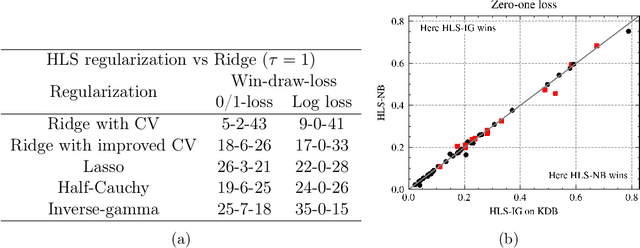

Abstract:Bayesian network classifiers (BNCs) possess a number of properties desirable for a modern classifier: They are easily interpretable, highly scalable, and offer adaptable complexity. However, traditional methods for learning BNCs have historically underperformed when compared to leading classification methods such as random forests. Recent parameter smoothing techniques using hierarchical Dirichlet processes (HDPs) have enabled BNCs to achieve performance competitive with random forests on categorical data, but these techniques are relatively inflexible, and require a complicated, specialized sampling process. In this paper, we introduce a novel method for parameter estimation that uses a log-linear regression to approximate the behaviour of HDPs. As a linear model, our method is remarkably flexible and simple to interpret, and can leverage the vast literature on learning linear models. Our experiments show that our method can outperform HDP smoothing while being orders of magnitude faster, remaining competitive with random forests on categorical data.
MONSTER: Monash Scalable Time Series Evaluation Repository
Feb 21, 2025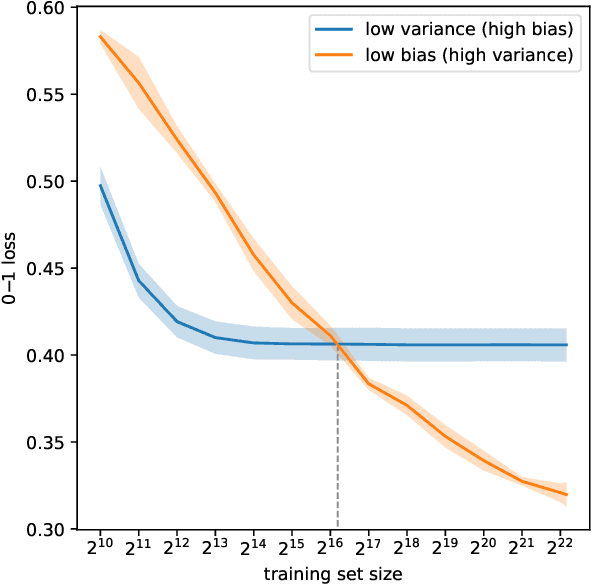
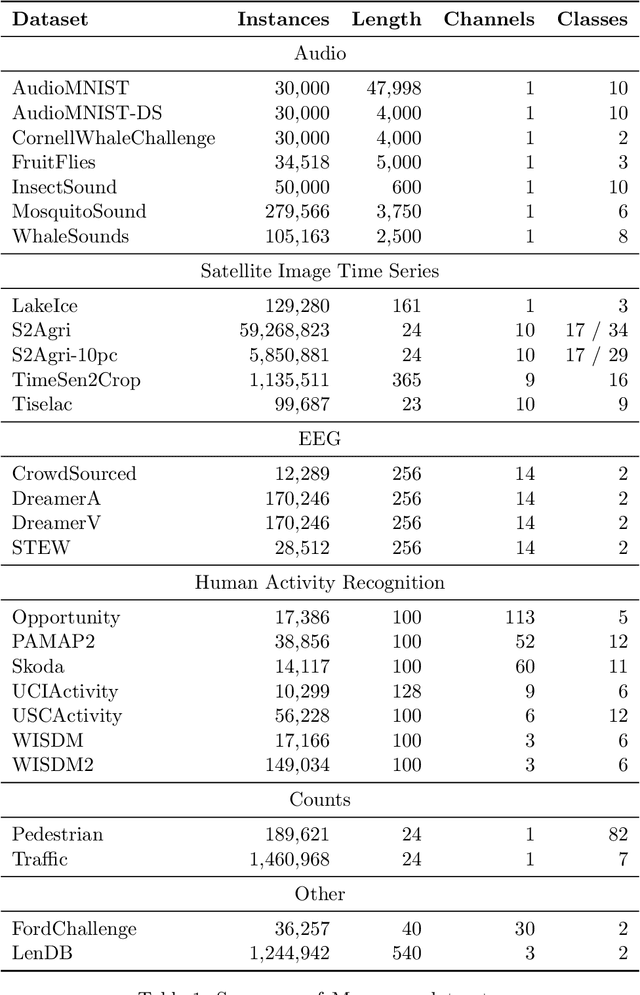
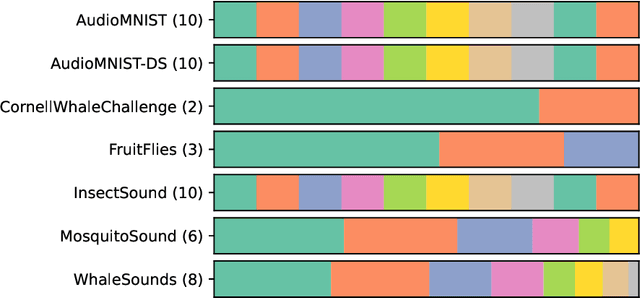
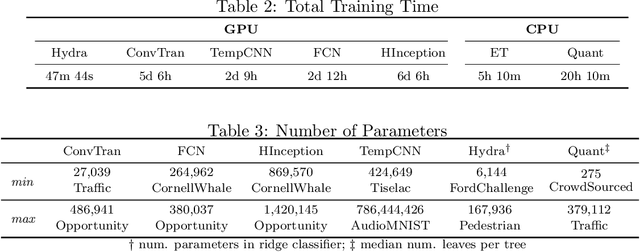
Abstract:We introduce MONSTER-the MONash Scalable Time Series Evaluation Repository-a collection of large datasets for time series classification. The field of time series classification has benefitted from common benchmarks set by the UCR and UEA time series classification repositories. However, the datasets in these benchmarks are small, with median sizes of 217 and 255 examples, respectively. In consequence they favour a narrow subspace of models that are optimised to achieve low classification error on a wide variety of smaller datasets, that is, models that minimise variance, and give little weight to computational issues such as scalability. Our hope is to diversify the field by introducing benchmarks using larger datasets. We believe that there is enormous potential for new progress in the field by engaging with the theoretical and practical challenges of learning effectively from larger quantities of data.
GenIAS: Generator for Instantiating Anomalies in time Series
Feb 12, 2025



Abstract:A recent and promising approach for building time series anomaly detection (TSAD) models is to inject synthetic samples of anomalies within real data sets. The existing injection mechanisms have significant limitations - most of them rely on ad hoc, hand-crafted strategies which fail to capture the natural diversity of anomalous patterns, or are restricted to univariate time series settings. To address these challenges, we design a generative model for TSAD using a variational autoencoder, which is referred to as a Generator for Instantiating Anomalies in Time Series (GenIAS). GenIAS is designed to produce diverse and realistic synthetic anomalies for TSAD tasks. By employing a novel learned perturbation mechanism in the latent space and injecting the perturbed patterns in different segments of time series, GenIAS can generate anomalies with greater diversity and varying scales. Further, guided by a new triplet loss function, which uses a min-max margin and a new variance-scaling approach to further enforce the learning of compact normal patterns, GenIAS ensures that anomalies are distinct from normal samples while remaining realistic. The approach is effective for both univariate and multivariate time series. We demonstrate the diversity and realism of the generated anomalies. Our extensive experiments demonstrate that GenIAS - when integrated into a TSAD task - consistently outperforms seventeen traditional and deep anomaly detection models, thereby highlighting the potential of generative models for time series anomaly generation.
Large Language Models in Drug Discovery and Development: From Disease Mechanisms to Clinical Trials
Sep 06, 2024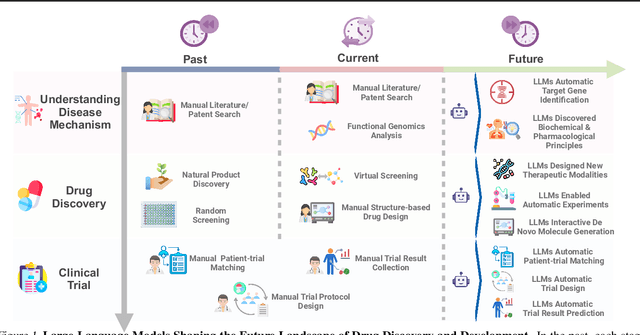
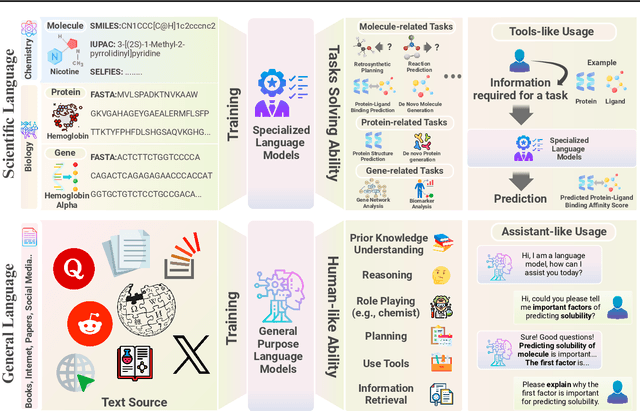
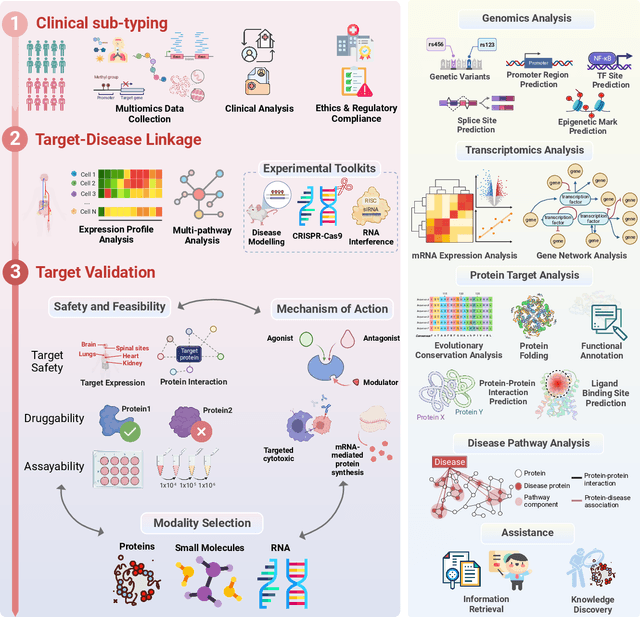
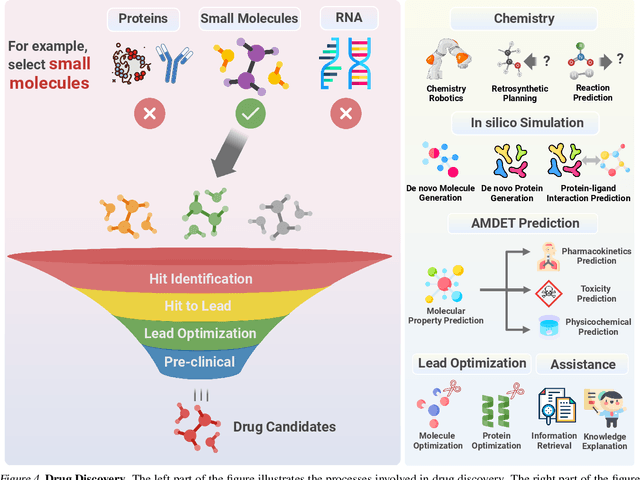
Abstract:The integration of Large Language Models (LLMs) into the drug discovery and development field marks a significant paradigm shift, offering novel methodologies for understanding disease mechanisms, facilitating drug discovery, and optimizing clinical trial processes. This review highlights the expanding role of LLMs in revolutionizing various stages of the drug development pipeline. We investigate how these advanced computational models can uncover target-disease linkage, interpret complex biomedical data, enhance drug molecule design, predict drug efficacy and safety profiles, and facilitate clinical trial processes. Our paper aims to provide a comprehensive overview for researchers and practitioners in computational biology, pharmacology, and AI4Science by offering insights into the potential transformative impact of LLMs on drug discovery and development.
Noise-Resilient Unsupervised Graph Representation Learning via Multi-Hop Feature Quality Estimation
Jul 29, 2024



Abstract:Unsupervised graph representation learning (UGRL) based on graph neural networks (GNNs), has received increasing attention owing to its efficacy in handling graph-structured data. However, existing UGRL methods ideally assume that the node features are noise-free, which makes them fail to distinguish between useful information and noise when applied to real data with noisy features, thus affecting the quality of learned representations. This urges us to take node noisy features into account in real-world UGRL. With empirical analysis, we reveal that feature propagation, the essential operation in GNNs, acts as a "double-edged sword" in handling noisy features - it can both denoise and diffuse noise, leading to varying feature quality across nodes, even within the same node at different hops. Building on this insight, we propose a novel UGRL method based on Multi-hop feature Quality Estimation (MQE for short). Unlike most UGRL models that directly utilize propagation-based GNNs to generate representations, our approach aims to learn representations through estimating the quality of propagated features at different hops. Specifically, we introduce a Gaussian model that utilizes a learnable "meta-representation" as a condition to estimate the expectation and variance of multi-hop propagated features via neural networks. In this way, the "meta representation" captures the semantic and structural information underlying multiple propagated features but is naturally less susceptible to interference by noise, thereby serving as high-quality node representations beneficial for downstream tasks. Extensive experiments on multiple real-world datasets demonstrate that MQE in learning reliable node representations in scenarios with diverse types of feature noise.
DACAD: Domain Adaptation Contrastive Learning for Anomaly Detection in Multivariate Time Series
Apr 17, 2024Abstract:Time series anomaly detection (TAD) faces a significant challenge due to the scarcity of labelled data, which hinders the development of accurate detection models. Unsupervised domain adaptation (UDA) addresses this challenge by leveraging a labelled dataset from a related domain to detect anomalies in a target dataset. Existing domain adaptation techniques assume that the number of anomalous classes does not change between the source and target domains. In this paper, we propose a novel Domain Adaptation Contrastive learning for Anomaly Detection in multivariate time series (DACAD) model to address this issue by combining UDA and contrastive representation learning. DACAD's approach includes an anomaly injection mechanism that introduces various types of synthetic anomalies, enhancing the model's ability to generalise across unseen anomalous classes in different domains. This method significantly broadens the model's adaptability and robustness. Additionally, we propose a supervised contrastive loss for the source domain and a self-supervised contrastive triplet loss for the target domain, improving comprehensive feature representation learning and extraction of domain-invariant features. Finally, an effective Centre-based Entropy Classifier (CEC) is proposed specifically for anomaly detection, facilitating accurate learning of normal boundaries in the source domain. Our extensive evaluation across multiple real-world datasets against leading models in time series anomaly detection and UDA underscores DACAD's effectiveness. The results validate DACAD's superiority in transferring knowledge across domains and its potential to mitigate the challenge of limited labelled data in time series anomaly detection.
 Add to Chrome
Add to Chrome Add to Firefox
Add to Firefox Add to Edge
Add to Edge